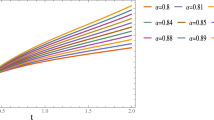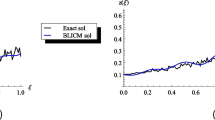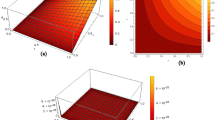Abstract
A procedure to construct temporally local schemes for the computation of fractional derivatives is proposed. The frequency-domain counterpart (iω)α of the fractional differential operator of order α is expressed as an improper integral of a rational function in iω. After applying a quadrature rule, the improper integral is approximated by a series of partial fractions. Each term of the partial fractions corresponds to an exponential kernel in the time domain. The convolution integral in a fractional derivative can be evaluated recursively leading to a local scheme. As the arguments of the exponential functions are always real and negative, the scheme is stable. The present procedure provides a convenient way to evaluate the quality of a given algorithm by examining its accuracy in fitting the function (iω)α. It is revealed that the non-classical solution methods for fractional differential equations proposed by Yuan and Agrawal (ASME J Vib Acoust 124:321–324, 2002) and by Diethelm (Numer Algorithms 47:361–390, 2008) can also be interpreted as applying specific quadrature rules to evaluate the improper integral numerically. Over a wider range of frequencies, Diethelm’s algorithm provides a more accurate fitting than the YA algorithm. Therefore, it leads to better performance. Further exploiting this advantage of the proposed derivation, a novel quadrature rule leading to an even better performance than Diethelm’s algorithm is proposed. Significant gains in accuracy are achieved at the extreme ends of the frequency range. This results in significant improvements in accuracy for late time responses. Several numerical examples, including fractional differential equations of degree α = 0.3 and α = 1.5, demonstrate the accuracy and efficiency of the proposed method.
Similar content being viewed by others
References
Abramowitz M, Stegun IA (1984) Pocketbook of mathematical functions. Verlag Harri Deutsch, Thun, Frankfurt/Main
Agrawal OP (2009) A numerical scheme for initial compliance and creep response of a system. Mech Res Commun 36: 444–451
Aoun M, Malti R, Levron F, Oustaloup A (2004) Numerical simulations of fractional systems: an overview of existing methods and improvements. Nonlinear Dyn 38: 117–131
Arkhincheev VE (1993) Anomalous diffusion in inhomogeneous media: some exact results. Model Meas Control A 26(2): 11–29
Bagley RL, Torvik PJ (1983) Fractional calculus—a different approach to the analysis of viscoelastically damped structures. AIAA J 21: 741–748
Bagley RL, Torvik PJ (1983) A theoretical basis for the application of fractional calculus to viscoelasticity. J Rheol 27(3): 203–210
Beyer WH (1978) Standard mathematical tables, 25th edn. CRC Press, Inc., West Palm Beach
Birk C, Song C (2009) A continued-fraction approach for transient diffusion in unbounded medium. Comput Methods Appl Mech Eng 198: 2576–2590
Birk C, Song C (2010) A local high-order doubly asymptotic open boundary for diffusion in a semi-infinite layer. J Comput Phys 229: 6156–6179
Carlson GE, Halijak CA (1964) Approximations of fractional capacitors (1/s)(1/n) by a regular newton process. IRE Trans Circuit Theory CT-11(2): 210–213
Chen Y, Vinagre BM, Podlubny I (2004) Continued fraction expansion approaches to discretizing fractional order derivatives - an expository review. Nonlinear Dyn 38: 155–170
Chen Y, Petrávs I, Xue D (2009) Fractional order control—a tutorial. In: 2009 American Control Conference, St. Louis, pp 1397–1411
Diethelm K (2008) An investigation of some nonclassical methods for the numerical approximation of Caputo-type fractional derivatives. Numer Algorithms 47: 361–390
Diethelm K (2009) An improvement of a nonclassical numerical method for the computation of fractional derivatives. J Vib Acoust 131
Koh CG, Kelly JM (1990) Application of fractional derivatives to seismic analysis of base–isolated models. Earthq Eng Struct Dyn 19: 229–241
Lu JF, Hanyga A (2005) Wave field simulation for heterogeneous porous media with singular memory drag force. J Comput Phys 208: 651–674
Oustaloup A, Levron F, Mathieu B, Nanot FM (2000) Frequency-band complex noninteger differentiator: characterization and synthesis. IEEE Trans Circuits Syst I Fundam Theory Appl 47(1): 25–39
Podlubny I (1999) Fractional differential equations, Mathematics in science and engineering, vol 198. Academic Press, Inc., San Diego
Podlubny I, Petrás I, Vinagre BM, O’Leary P, Dorčák L (2002) Analogue realizations of fractional-order controllers. Nonlinear Dyn 29: 281–296
Rossikhin YA, Shitikova MV (1997) Applications of fractional calculus to dynamic problems of linear and nonlinear hereditary mechanics of solids. Appl Mech Rev 50(1): 15–67
Roy SCD (1967) On the realization of a constant-argument immitance or fractional operator. IEEE Trans Circuit Theory 14(3): 264–274
Ruge P, Trinks C (2004) Consistent modelling of infinite beams by fractional dynamics. Nonlinear Dyn 38: 267–284
Ruge P, Wagner N (1999) Time–domain solutions for vibration systems with fading memory. In: Wunderlich W (ed) European conference on computational mechanics, Munich, pp 367–374, published on CD–ROM
Schmidt A, Gaul L (2006) On a critique of a numerical scheme for the calculation of fractionally damped dynamical systems. Mech Res Commun 33: 99–107
Schneider WR (1990) Dynamics and stochastic processes theory and applications, Springer, chap Fractional diffusion. Lecture Notes in Physics
Shokooh A, Suarez L (1999) A comparison of numerical methods applied to a fractional model of damping materials. J Vib Control 5: 331–354
Torvik PJ, Bagley RL (1984) On the appearance of the fractional derivative in the behavior of real materials. J Appl Mech 51: 294–298
Trinks C, Ruge P (2002) Description of wave propagation by fading memory. In: Grundmann H, Schuëller GI (eds) Structural dynamics – Eurodyn 2002, Swets & Zeitlinger B.V., Munich, pp 711–716
Trinks C, Ruge P (2002) Treatment of dynamic systems with fractional derivatives without evaluating memory–integrals. Comput Mech 29: 471–476
Tseng CC, Pei SC, Hsia SC (2000) Computation of fractional derivatives using fourier transform and digital FIR differentiator. Signal Process 80: 151–159
Vinagre BM, Podlubny I, Hernandez A, Feliu V (2000) Some approximations of fractional order operators used in control theory and applications. Fract Calculus Appl Anal 3(3): 231–248
Yuan L, Agrawal OP (2002) A numerical scheme for dynamic systems containing fractional derivatives. J Vib Acoust 124: 321–324
Zhang W, Shimizu N (1998) Numerical algorithm for dynamic problems involving fractional operators. JSME Int J Ser C 41(3): 364–370
Author information
Authors and Affiliations
Corresponding author
Rights and permissions
About this article
Cite this article
Birk, C., Song, C. An improved non-classical method for the solution of fractional differential equations. Comput Mech 46, 721–734 (2010). https://doi.org/10.1007/s00466-010-0510-4
Received:
Accepted:
Published:
Issue Date:
DOI: https://doi.org/10.1007/s00466-010-0510-4




